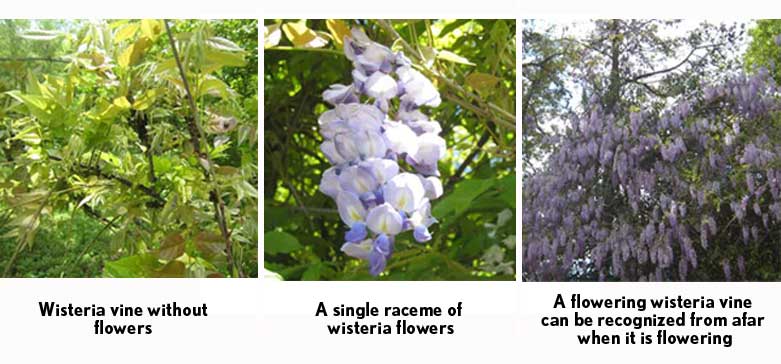More Information about Wisteria:
What wisteria looks like:
Wisteria is a climbing woody vine with alternate leaves that are 15-35 cm long. Each leaf has 9 or more leaflets, which are bronze when young, but turn green as they age. The flowers grow in racemes which can be 10-80 cm long, and are purple to white. The flowers smell sweet, like grape soda.

The genus Wisteria is comprised of 5 species: two polyploid species native to America, one diploid species native to China (W. sinensis), and two diploid species native to Japan (W. brachybotrys and W. floribunda). The native ranges of Chinese and Japanese wisteria do not overlap (Valder, 1995). Japanese wisteria was introduced to the United States in 1862, when it was sent to a nursery in Flushing, New York (Wyman, 1949). Chinese wisteria was introduced to the United States prior to this, potentially as early as 1816 (Coats, 1963; Wilson, 1916). In Sierra Madre, California, a cultivar of Chinese wisteria was planted in 1893, and this 119 year old plant continues to draw thousands of visitors each year for the annual Wistaria Festival (Valder, 1995).
W. sinensis and W. floribunda have escaped gardens, become naturalized in the United States and hybridized, so morphological characteristics are not useful to distinguish between species (Trusty et al., 2007a). Asian wisterias have not hybridized with American wisterias due to differences in ploidy (Trusty et al., 2007b; Valder, 1995). Surprisingly little has been published on the invasive status and range of wisteria, or attempts to control it. Fact sheets published by the USDA Forest Service (Remaley, 2005) or DNR are authoritative in the scientific community, despite not being peer reviewed. So while the invasive range of Chinese and Japanese wisteria is reported to include the eastern half of the United Stated, wisteria continues to be planted as an ornamental across the country (Remaley, 2005; Valder, 1995).
Wisteria flowers are bee pollinated and grow in showy, sweet smelling racemes that may have up to 170 flowers, but only 1 or 2 will produce pods (Valder, 1995). In late winter pods break open and large seeds are flung away from the vine. Wisteria also has the tendency to reproduce vegetatively, and chokes out native flora, so eventually grown in monoculture. Wisteria grows best in full sun and can grow in a variety of soil types, and most often colonizes disturbed areas, forest edges, and riparian zones (Trusty et al., 2007b).
References:
Coats, A.M. (1963). Wisteria. In Garden Shrubs and their Histories (New York, E. P. Dutton & Company), pp. 362-364.
Remaley, T. (2005). PCA Fact Sheet: Exotic Wisterias (Plant Conservation Alliance's Alien Plant Working Group).
Trusty, J.L., Johnson, K.J., Lockaby, B.G., and Goertzen, L.R. (2007a). Bi-parental cytoplasmic DNA inheritance in Wisteria (Fabaceae): Evidence from a natural experiment. Plant and Cell Physiology 48, 662-665.
Trusty, J.L., Lockaby, B.G., Zipperer, W.C., and Goertzen, L.R. (2007b). Identity of naturalised exotic Wisteria (Fabaceae) in the south-eastern United States. Weed Research 47, 479-487.
Valder, P. (1995). Wisterias: A comprehensive guide (Potland, Oregon, Timber Press).
Wilson, E.H. (1916). The Wisterias of China and Japan. The Gardeners' Chronicle 1545, 61-62.
Wyman, D. (1949). The Wisterias. Arnoldia 9, 17-28.
©2014 Sandra Hoffberg
